British and European Car Spotters Guide - 1955 |
|
|
 |
|
|
|
With the memories of the difficult post-war years hopefully beginning to fade, the British motor industry moved into the second half of the fifties intent on keeping and expanding its world trade despite the growing threat of intensive competition from other countries. After developing and producing a number of small economy saloons during the early fifties, the industry generally seemed to turn its attention to enlarging and improving the larger cars for 1955. Austin replaced their four-cylinder Hereford with the six-cylinder A90 Westminster; Daimler added five new large models to their range; Aston Martin, Bentley, Jaguar and Rolls-Royce increased the power of their engines; Morris introduced the six-cylinder Isis and Wolseley the Six/Ninety.
There was also strong evidence that British manufacturers were beginning to recognize what the Americans had accepted years before-that women have a considerable say where the potential car buyer is concerned. Sadly a number of car manufacturers went the way of all flesh during the latter part of 1954 or in 1955, namely Lea-Francis, Jowett and Swallow. Lanchester followed soon after. Of the 905,623 cars produced during the year, 388,564 were exported and 517,059 were UK registrations (including 5,639 hackneys). Imports were, however, more than double the previous year's-11, 131 v. 4660 cars of 1953, did not in fact reach the production stage until later the following year by which time a number of modifications had been made. |
 |
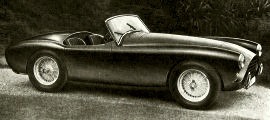 |
 |
AC Ace |
| |
Also see: AC Car Reviews | The History of AC (AUS Edition) |
| |
For 1955 the AC Ace's headlamps were raised and positioned alongside a recessed, raked-back radiator grille, the alloy body was carried by a stronger tubular frame, cam steering replaced the rack and pinion variety and the suspension layout was revised slightly. Powered by a six-cylinder 1991-cc engine which produced 76 bhp at 4500 rpm, it featured all independent suspension. A two-seater hard-top coupe - the Aceca - was also added. |
|
 |
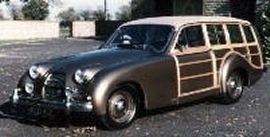 |
 |
Allard Safari Estate |
| |
Also see: Allard Car Reviews | The History of Allard |
| |
The Allard Safari estate car was mechanically similar to the contemmporary Allard P2 Monte Carlo saloon (so named to commemorate Sydney Allard's outright victory in the 1952 Monte Carlo Rally). Both had a Ford V8 engine as standard but otherrmore powerful-engines could be fitted at extra cost. The Safari had three bench seats, the rearmost facing backwards, and, at 16 ft 6 in, was 6 in longer than the saloon. In October 1955 both models were listed at £2525 12s 6d. |
|
 |
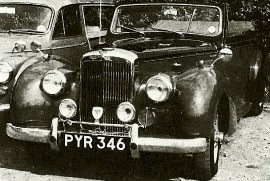 |
 |
Alvis Three liter TC21-100 Drophead Coupe |
| |
Also see: Alvis Car Reviews | The History of Alvis |
| |
The Alvis Three liter TC21-100 Drophead Coupe was an impressive Tickford-bodied two-door alternative to the Grey Lady four-door Saloon. Both models were fitted with the 2993-cc 100-bhp twin-carburetor engine and featured a sunshine roof (saloon). wire wheels and a pair of additional driving lamps as standard: pressed wheels were optionally available. Body supply problems, alas, meant that the Coupe was disconntinued in August 1955. Tickford was acquired about that time by the David Brown group, which made the Aston Martin and Lagonda cars. |
|
 |
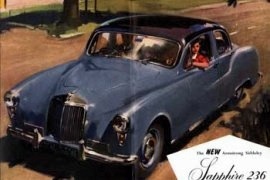 |
 |
Armstrong Siddeley Sapphire 236 |
| |
Also see: The History of Armstrong Siddeley |
| |
The Armstrong Siddeley Sapphire 346 luxury saloon. powered by a six-cylinder. 3A-liter engine This Mark II version featured a number of modifications including flashing trafficators, rubber stoneguards, larger brake drums, automatic light switches for bonnet and boot and additional dash warning lights: automatic transmission was optionally available. It became the first British car to list power-assisted steering as an optional extra, in the summer of 1955. |
|
 |
 |
 |
Armstrong Siddeley Limousine |
| |
Also see: The History of Armstrong Siddeley |
| |
The Armstrong Siddeley Limousine was a long-wheelbase seven / eight-seater version, mechanically similar to the 346 saloon but some 5 cwt heavier, 19 in longer and 2 in higher. Wheelbase was 133 in (114 in on the Saloon). Tyre size was 7.00-16 in. |
|
 |
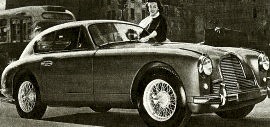 |
 |
|
| |
Also see: Aston Martin Car Reviews | The History of Aston Martin |
| |
The Aston Martin DB2-4 was vailable as Sports Saloon and Drophead Coupe, this model was fitted with a 3-liter twin-overhead-camshaft engine, developing 140 bhp at 5000 rpm, from about the middle of 1954. The occasional rear seats, which were suitable mainly for children, could, on the saloon, be folded down to give a long flat luggage platform reached via the top-hinged opening rear panel. |
|
 |
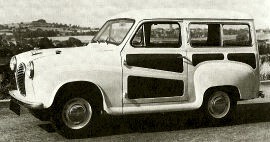 |
 |
Austin A30 Model AP4 Countryman |
| |
Also see: Austin Car Reviews | The History of Austin (AUS Edition) |
| |
The Austin A30 Model AP4 Countryman was mechanically similar to the saloon version, this two-door utility model had a squarish metal-panelled body, with a single rear seat. Dimensions: length 11 ft 6 in. width 4 ft 8 in. height 5 ft 3 in. The two-door and four-door saloons were continued with no material changes. |
|
 |
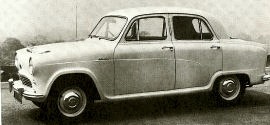 |
 |
Austin A40 Cambridge Saloon Model GS5 |
| |
Also see: Austin Car Reviews | The History of Austin (AUS Edition) |
| |
The Austin A40 Cambridge Saloon, Model GS5. Following on the tradition of the Devon and Somerset A40s, this four-door model and a limited number of two-door models were built. They had a completely new flush-sided body which featured a low, wide grille with five 'rippled' horizontal bars, a dummy air scoop on the bonnet nose. and straight-through wings. Powered by the reliable 1200-cc 42-bhp engine, it had a 6¾ in longer wheelbase than its predecessor (the Somerset) and yet was only 2¾ in longer overall. Also available was the A50, which was a bigger-engined version-1489-cc develping 50 bhp at 4400 rpm. |
|
 |
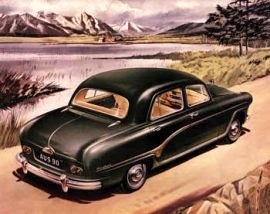 |
 |
Austin A90 Westminster |
| |
Also see: Austin Car Reviews | The History of Austin (AUS Edition) |
| |
The Austin A90 Westminster Model 8S4 Saloon had a similar body to the A40/ A50 Cambridge but with detail differences such as a seven-bar grille. chrome body-side mouldings and greater overall dimensions. It was powered by a six-cylinder 2639-cc 85-bhp engine coupled with a four-speed gearbox; overdrive or automatic transmission were optional. The A90 was replaced by the A95 in October 1956. |
|
 |
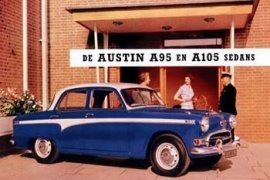 |
|
 |
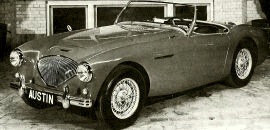 |
 |
Austin-Healey 100 Sports |
| |
Also see: Austin Healey Car Reviews |
| |
The Austin-Healey 100 Sports was a 2·6-liter engined, sleek, low-contoured sports two-seater was continued from 1954 with no material changes to the standard model specification. Late in 1954, however, a modified version for sports-car racing was evolved, namely the 100S. Apart from the basic body and chassis structure it was virtually a new car, recognizable by its wide shallow oval grille, shallow frameless curved Perspex windscreen and aluminum alloy body panelling. The much-modified power unit gave it a power output of 132 bhp at 4700 rpm. A supercharged development of the 100S, driven by Donald Healey, reached 192·6 mph at the Utah Salt Flats in the United States. |
|
 |
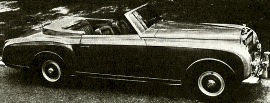 |
 |
|
| |
Also see: Bentley Car Reviews | The History of Bentley |
| |
The 1955 Bentley Continental was fitted with a larger engine (4887cc; previously 4566cc). This superb model was continued with the addition of two new versions from Park Ward Ltd, namely the Sports Saloon and the Drophead Coupe. The original H J. Mulliner Saloon was also available. Automatic transmission could be supplied at extra cost on all models. |
|
 |
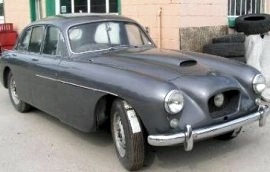 |
 |
|
| |
Also see: Bristol Car Reviews |
| |
The Bristol 405 Saloon was the first four-door model produced by the Bristol company. It was similar to the 404 at the front but was considerably longer (15 ft 9-a in v. 14 ft 3-a in), giving comfortable seating for four people and was powered by a 1971-cc engine which developed 105 bhp at 5000 rpm. A Drophead Coupe version with coachwork by Abbott of Farnham was also available. The 403 and 404 models were continued until October 1955. |
|
 |
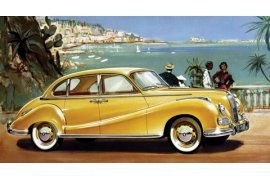 |
 |
BMW 502 |
| |
Also see: BMW Car Reviews | The History of BMW |
| |
The BMW 501 was introduced at the first Frankfurt Motor Show in 1951, the 501 being the first motor car to be manufactured and sold by BMW after World War 2. The 501 and V8 powered BMW 502, were nicknamed “Baroque Angels” by the German public. The BMW 502 was the first postwar German car to be manufactured with a V8 engine. While the 501 and 502 model numbers were discontinued in 1958, variations of the model, with the same platform and body, were continued until 1963. |
|
 |
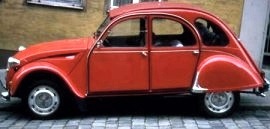 |
 |
|
| |
Also see: Citroen Car Reviews | The History of Citroen (AUS Edition) |
| |
The Citroen 2CV front-wheel drive car was continued with the introduction of the AZ, which was an improved version of the existing A model. The most important modification was the adoption of a larger engine 425-cc which raised the output to 12 bhp (was 9 bhp with the A model's 375 cc engine). The A model was discontinued in July 1955. |
|
 |
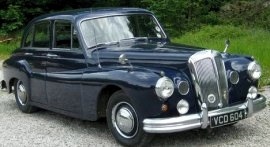 |
 |
Daimler Regency Mark II DF 304 Saloon |
| |
Also see: Daimler Car Reviews | The History of Daimler (AUS Edition) |
| |
The Daimler Regency Mark II DF 304 Saloon was one of five new Daimler models introduced for 1955 and based on variants of two engines and two chassis types. The four-door saloon version shown had a 3~-liter engine; also available was a 4·6-liter version (Series DF400). The two Regency and two Sportsman Saloon models were mounted on a 114-in wheelbase, whereas the Regina seven-seater Limousine had a 130-in wheelbase chassis. The Conquest models were continued. |
|
 |
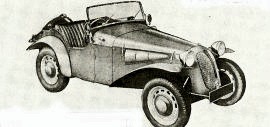 |
 |
Dellow Mark II B and C Two-Seater |
| |
|
| |
The Dellow Mark II (B and C) Two-Seater was continued from the previous year without any material changes. This Ford-based competition sports model was powered by an 1172-cc engine and featured a body panelled in aluminum, mounted on a stout tubular frame. Also available was a Mark V version, recognizable by an oval air intake with vertical bars, and broad flat bonnet. The Mark II B was discontinued in 1956. |
|
 |
|
|
 |
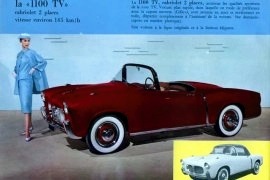 |
|
 |
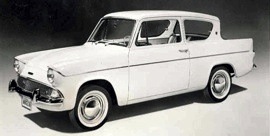 |
|
 |
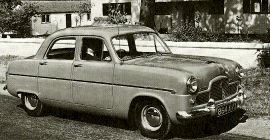 |
 |
Ford Zephyr Saloon Model EOTTA |
| |
Also see: Ford UK Car Reviews | The History of Ford |
| |
The Ford Zephyr Saloon, Model EOTTA, was continued from 1954-together with the convertible version and the Zodiac and Consul (EOTA) saloons and convertibles-with detail modifications. The Zephyr and Zodiac featured a six-cylinder 2262-cc engine which developed 68 bhp (71 bhp on the Zodiac) at 4200 rpm. The Consul had a four-cylinder 1508-cc engine. |
|
 |
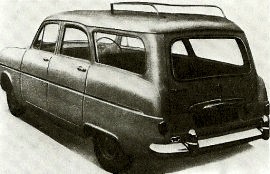 |
 |
Ford Zephyr Estate Model EOTTA |
| |
Also see: Ford UK Car Reviews | The History of Ford |
| |
The Ford Zephyr Estate Car, a conversion of the saloon by Abbott of Farnham. Originally the subject of a draughtsman's lunchtime doodle, this 'luggage-locker-extension design' became so popular that cars were soon being converted for export. |
|
 |
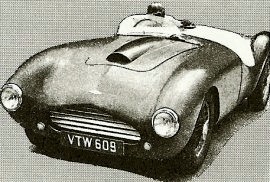 |
 |
Frazer-Nash Sebring |
| |
Also see: The History of Frazer-Nash |
| |
The Frazer-Nash Sebring was an impressive two-seater which was named in honour of the Frazer-Nash victory in the twelve-hour endurance race at Sebring. In 1952, was continued with no material changes. Powered by the famous six-cylinder 2-liter Bristol engine it was developed from the Mark II Competition model. It featured a full-width body of more rounded form, and a low-set lozenge-shaped radiator grille. |
|
 |
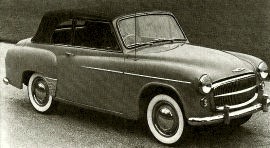 |
 |
Hillman Minx De Luxe Saloon, Convertible and Californian Hard-top |
| |
Also see: Hillman Car Reviews | The History of Hillman (AUS Edition) |
| |
The Hillman Minx De Luxe Saloon, Convertible and Californian Hard-top models continued as Mark VIII with a number of modifications including a new 1390-cc 47-bhp overhead-valve engine, restyled radiator grille. sidelamp plinths and flashing trafficators, smaller wheels (15 in v. 16 in) and improvements to the suspension, The Special Saloon and the Estate Car retained the 1265-cc side-valve engine (until October). All models had 7 ft 9 in wheelbase. Of the Estate Car there was a Commer 8-cwt van variant. |
|
 |
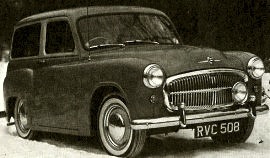 |
 |
Hillman Husky |
| |
Also see: Hillman Car Reviews | The History of Hillman (AUS Edition) |
| |
The Hillman Husky first appeared in late 1954, for the 1955 model year, as a compact handy little estate car powered by the Minx 1265-cc side-valve engine and fitted with many of its mechanical parts, although it had shorter wheelbase (7 ft) and body. The Husky featured individual front seats, fold-down rear bench seat and a single side-hinged rear door. The radiator grille was similar to that of the Minx Mark VIII. From early 1956 the Husky was also available as a 7-cwt panel van. named Commer Cob. |
|
 |
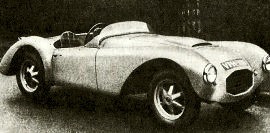 |
 |
HRG 1½-liter Sports |
| |
|
| |
HRG 1½-liter Sports/Racing car, Following on the traditions of this famous sports-car manufacturer in Tolworth. Surrey. but vastly different from its predecessors, this car featured an attractive full-width light-alloy body. braced twin-tube chassis with transverse spring suspension (front and rear), a 1497-cc 108-bhp engine and cast magnesium spider wheels, but never progressed beyond the prototype stage as the company ceased car production in 1956. |
|
 |
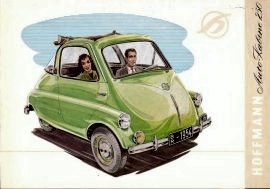 |
 |
Hoffmann Auto Kabine 250 |
| |
|
| |
|
|
 |
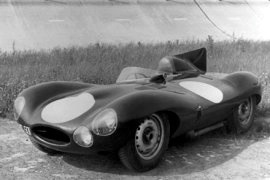 |
|
 |
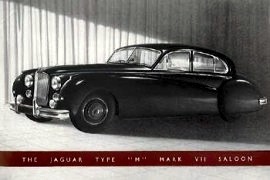 |
 |
Jaguar Mark VII M Saloon |
| |
Also see: Jaguar Car Reviews | Jaguar - A Racing Pedigree | The History of Jaguar |
| |
Jaguar Mark VII M Saloon was similar to the Mark VII but with increased power output (as on the XK140) and modified front end treatment which included new wrapround bumpers, exterior mounted fog lamps, horn grilles below the headlamps, flashing trafficators and rim embellishers as standard equipment. |
|
 |
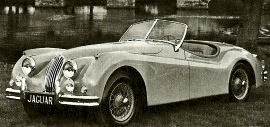 |
 |
|
| |
Also see: Jaguar Car Reviews | Jaguar - A Racing Pedigree | The History of Jaguar |
| |
The Jaguar XK140 Roadster was a renamed version of the XK120 of former years; with the new name came an increase in power from the famous 3½-liter engine which had been so successful on the international sports car racing front since the war. The 3442-cc power unit developed 190 bhp at 5500 rpm (160 bhp on XK120) Also available were Drophead Coupe and Fixed-Head Coupe versions. Externally they were distinguishable from the XK120 by bolder grille bars and wrapround bumpers. |
|
 |
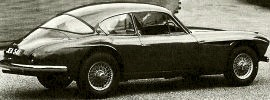 |
 |
Jensen 541 4-liter Sports Saloon |
| |
Also see: Jensen Car Reviews | The History of Jensen |
| |
The Jensen 541 4-liter Sports Saloon continued with slight modifications. When first announced (in October 1953) it had an aluminum body, but by the time production started (early in 1955) a reinforced plastic version was used. The car was powered by an Austin 125 six-cylinder engine, with triple carburetors as standard. |
|
 |
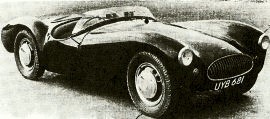 |
 |
Jenard Jabeka Sports Prototype |
| |
|
| |
The Jenard Jabeka Sports was designed and built by G A. Elsmore, chief flight observer of the Westland Aircraft Co of Yeovil, Somerset. This attractive two-seater was to be available with a choice of four power units-Supercharged Austin A40 and A50, MG 1½-liter and Coventry Climax, but never reached the producction stage - only prototypes were built. |
|
 |
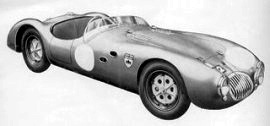 |
 |
Kieft 1100 Sports |
| |
|
| |
The was an open two-seater produced by Kieft Cars Ltd of Wolverhampton under the direction of Mr Cyril Kieft. It featured a Coventry Climax overhead-camshaft engine and moulded fiberglass bodywork. A Kieft was the only British car to win International Class honours on two occasions in the 1954 World's Sports Car Championship. It was available also with a 1500-cc flat-four engine with four overhead camshafts. |
|
 |
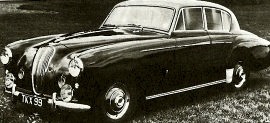 |
 |
Lagonda 3-liter Saloon |
| |
Also see: The History of Lagonda |
| |
The Lagonda 3-liter Saloon, a Tickford-bodied four-door model which was basically similar to the two-door saloon except that the chromium strips on the body sides were longer and the rear side windows had louvres. Also available was a Dropphead Coupe. The two-door saloon was discontinued at the end of 1954. |
|
 |
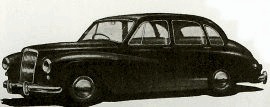 |
 |
Lanchester Sprite Mark II Saloon |
| |
Also see: The History of Lanchester |
| |
The Lanchester Sprite Mark II Saloon was a much modified and restyled version of the ill-fated Mark I which never actually reached the production stage (only three were ever built). A 1622-cc engine, which developed 60 bhp at 4200 rpm, drove through a Hobbs automatic transmission. Only ten of these were built before Lanchester ceased operations. |
|
 |
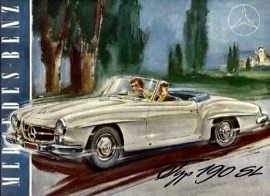 |
|
 |
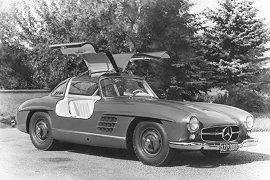 |
 |
|
| |
Also see: Mercedes-Benz SL Car Reviews | The History of Mercedes-Benz |
| |
The most noteable feature of the 300 SL Mercedes-Benz were the "gullwing" doors that opened upward. The two wide doors were held in the open position by encased telescopic springs. This design was developed to make it easier to enter and exit the sports car. The 300 SL inherited its features from the Mercedes-Benz racing vehicles of the fifties. The gullwing had a torsionally rigid, three dimensional tubular steel frame that weighed 50 kg (110 lb). The body was fastened to this "space frame" to give a firm ride and handling package. Curb weight of the 300 SL was 1295 kg (2855 lb). The 300 SL was powered by a six cylinder overhead cam engine displacing 3.0 L and achieving 164 kW (220 hp) at 6100 rpm. Maximum torque was 294 Nm (217 lb.ft) at 4800 rpm. Bore was 84.8 mm (3.34 in) and stroke was 88·1 mm (3.47 in) with a compression ratio of 8·55:1. The engine was equipped with direct fuel injection, which was unusual for vehicles of that time. The front-engine, rear-wheel drive vehicle had four-wheel independent suspension. The front wheels had a parallel wishbone arm setup with coil springs and hydraulic shock absorbers. The rear swing axle also used coil springs and hydraulic shocks to give it its well known stability in curves and excellent roadability. The brakes were full hydraulic with a servo assist. The brake shoes were self-adjusting and used "turbo-cooled" bi-metal brake drums. |
|
 |
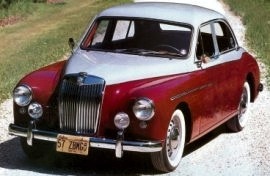 |
 |
MG Magnette Series ZA Saloon |
| |
Also see: MG Car Reviews | The MG Story | The History of MG |
| |
The MG Magnette Series ZA Saloon was continued with a modified facia. This smart four-seater featured a twin-carburetor 1½-liter OHV engine, a full-width body with a curved radiator cowl of familiar MG form and a well-appointed interior which included pile carpets, leather upholstery and wooden facia. |
|
 |
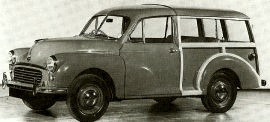 |
 |
Morris Minor Traveller Estate |
| |
Also see: Morris Car Reviews and The History of Morris (AUS Edition) |
| |
The Morris Minor Traveller estate car was continued, together with the two- and four-door saloons and convertible versions, with a number of changes including a restyled radiator grille, modified rear light units and a revised instrument panel layout. It became one of the most popular Morris cars ever made. |
|
 |
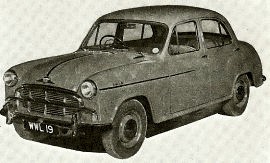 |
 |
Morris Isis |
| |
Also see: Morris Car Reviews and The History of Morris (AUS Edition) |
| |
The Morris Isis was introduced in February 1955 and was available as standard or de luxe Saloon or as a Traveller estate car. They were of similar appearance to the Oxford Series II but had the letters ISIS on each front wing, above the chrome flash, and featured a six-cylinder 2639-cc engine. Automatic transmission was optionally available, as an alternative to the standard four-speed manual type. |
|
 |
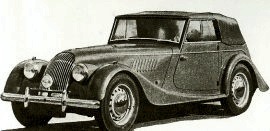 |
 |
Morgan Plus Four |
| |
Also see: Morgan Car Reviews | The History of Morgan |
| |
Morgan Plus Four two and four-seater Tourer and two-seater Coupe models were continued for 1955 with minor changes and were joined by a new four-seater Coupe. Powered by the 2-liter (2088-cc) Standard Vanguard engine these traditional sports cars featured a curved-back radiator with vertical chrome bars and faired-in headlamps. The two-seater Tourer was also available with the 1·9-liter (1991 -cc) Triumph TR2 engine, a power unit which became standard equipment for all models in 1958. |
|
 |
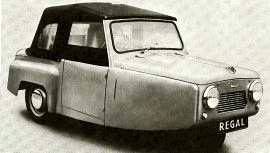 |
 |
Reliant Regal Coupe Mark II |
| |
Also see: Reliant Car Reviews | The History of Reliant (AUS Edition) |
| |
The Reliant Regal Coupe Mark II was a modified version of the original three-wheeler first introduced late in 1951. It had a 747·5-cc engine, fourrspeed gearbox, box section pressed - steel chassis and hydraulic brakes, Wheelbase measured 74 in. The list price was £403. |
|
 |
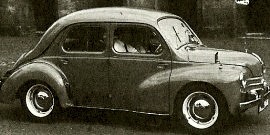 |
 |
Renault 750 Saloon, Model R1062 |
| |
Also see: Renault Car Reviews | The History of Renault |
| |
The Renault 750 Saloon, Model R1062, was assembled both in its native France (designated 4CV) and also in England, using a considerable amount of British material. The rear-engined saloon was a very popular little car. It featured a 748-cc 21-bhp engine and all-independent suspension and was continued with detail modifications which included twin horn grilles 14A Renault 750 on the bumper bracket. flashing trafficators and diamond-shaped badge. |
|
 |
 |
 |
Riley Pathfinder Model RMH Saloon |
| |
Also see: Riley Car Reviews | The History of Riley |
| |
The Riley Pathfinder Model RMH Saloon continued into its second year of production with minor changes. Powered by a sturdy 2½-liter 110-bhp four-cylinder engine, it featured four-light full-width bodyywork with a typical Riley radiator grille. |
|
 |
 |
 |
|
| |
Also see: Rolls-Royce Car Reviews | The History of Rolls-Royce |
| |
The RoIIs-Royce Silver Cloud was announced in the spring of 1955 and was virtually identical to the S- Type Bentley, except for the radiator shell design and wheel hub caps. The standard steel body had aluminum bonnet, door and boot lid panels. The 4887-cc engine-similar to the Bentley Continental power unit-had twin SU carburetors and a 6·6:1 compression ratio. As usual, the power output and torque figures were not disclosed. Automatic transmission was standard-a manual gearbox was not offered. Also available was the Silver Wraith Series E chassis. The Silver Dawn was discontinued in 1955. |
|
 |
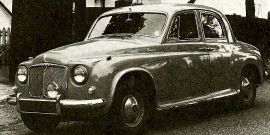 |
 |
|
| |
Also see: Rover Car Reviews | The History of Rover (AUS Edition) |
| |
The Rover 90 Saloon continued-along with the other, similar bodied, P4 models (60 and 75)-with a number of changes including flashing trafficators as standard to replace the front-wing reflectors, vertical three-piece tail lights, a wider three-piece rear window, repositioned boot lid, larger front brakes (75 and 90) and a modified parking brake. The 75 also had a new engine - 2230 cc, giving 80 bhp at 4500 rpm and the 90 engine (2638 cc, 90 bhp) had a raised compression ratio which gave it a slight increase in power output. |
|
 |
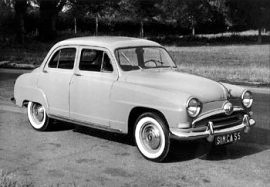 |
|
 |
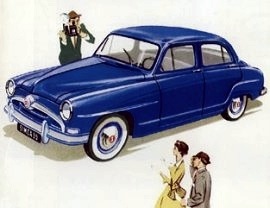 |
|
 |
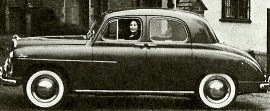 |
 |
Singer Hunter Saloon |
| |
Also see: Singer Car Reviews | The History of Singer |
| |
The Singer Hunter Saloon was announced in September 1954, the medium-sized four-door Hunter model superseded the 1948-54 SM 1500 Saloon. The bodystyling was basically similar, except for the radiator grille which was of the upright 'traditional' type, sporting a horse's head mascot The Hunter featured a modified version of the established four-cylinder 1½-liter OHC engine, fiberglass bonnet panels, twin fog lamps and a fitted tool drawer in the boot |
|
 |
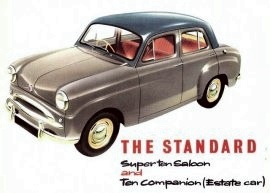 |
 |
Standard Ten |
| |
Also see: Standard Car Reviews | The History of Standard |
| |
The Standard Ten Saloon was introduced in 1954 to fill the gap between the 2-liter Vanguard and the Eight It was a four-light fourrdoor saloon, powered by a 948-cc 33-bhp engine. Externally the Ten was distinguishable from the Eight by its more elaborate radiator grille. |
|
 |
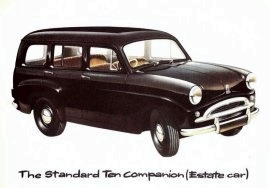 |
 |
Standard Ten Estate (or "Good Companion") |
| |
Also see: Standard Car Reviews | The History of Standard |
| |
Also available in the Standard Ten range was an Estate Car version with steel panelled sixxlight four-seater body. The latter was known as the Ten Companion (originally 'Good Companion'). |
|
 |
 |
 |
Sunbeam 90 Mark III Saloon and Drophead Coupe |
| |
Also see: Sunbeam Car Reviews | The History of Sunbeam |
| |
Sunbeam 90 Mark III Saloon and Drophead Coupe. These high perforrmance 2¼-liter engined sports models were continued with a number of changes which included engine modifications-increased bhp-slotted wheel discs. laterally extended air intake grilles. air exit portholes in the scuttle sides and a redesigned facia panel. It achieved many successes in international rallies during the late' 40s and the '50s. The name Talbot was dropped from the car name plates in the summer of 1954. |
|
 |
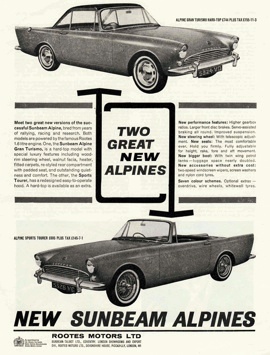 |
 |
Sunbeam Alpine |
| |
Also see: Sunbeam Car Reviews | The History of Sunbeam |
| |
The Sunbeam Alpine open two-seater sports model was mechanically similar to the 90 from which it was developed. primarily for export. Externally it was distinguishable from the 90 Drophead Coupe by its flatter rear end. smaller. deeper air-intakes beside the radiator. separate sidelamps and the absence of door handles and scuttle portholes. The Alpine broke two records in Belgium on its first road test; the flying mile at 119.402 mph and the flying kilometre at 120.132 mph. |
|
 |
 |
 |
Swallow Doretti Sports |
| |
|
| |
The Swallow Doretti Sports was an attractive aluminum-and-steel-bodied two-seater built by the Swallow Coachbuilding Co. (1935) Ltd, of Walsall, Staffs and featuring the well-proved 2-liter Triumph TR2 engine mounted in a rigid chassis frame. Regrettably the model was in producction for little more than one year - announced in March 1954 - with initial orders being confined to the American market. Wheelbase was 7 ft 7 in, overall length 13 ft width 5 ft 1 in. |
|
 |
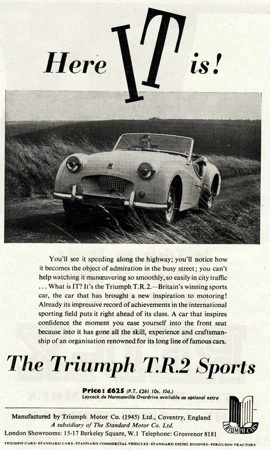 |
 |
Triumph TR2 Sports |
| |
Also see: Triumph Car Reviews | The History of Triumph |
| |
The Triumph TR2 Sports continued with only minor changes, although the Convertible was joined by a Hard-top (detachable fiberglass unit) version. Powered by a 1991-cc linered-down version of the Standard Vanguard 2-liter (2088cc) engine, this very popular sports car featured a full-width body with a squarish opening to the radiator grille. |
|
 |
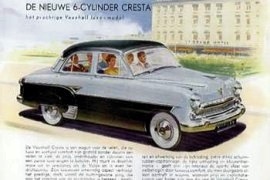 |
 |
Vauxhall Cresta |
| |
Also see: Vauxhall Car Reviews |
| |
The Vauxhall Cresta Model El PC was a new luxury version of the Velox Saloon, added to the four-cylinder 1507-cc engined Wyvern (EIX) and the six-cylinder 2262-cc engined Velox (EIPV) which were conntinued with a 'new look' front end and various detail modifications. All three models featured a wide simple radiator grille incorporating the sidelamps The Cresta was distinguished from the Velox by, among other features, white-wall tires, chromium wheel rim embellishers, and numerous interior refinements such as leather upholstery, coat hangers and a heater as standard. |
|
 |
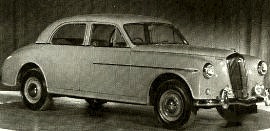 |
 |
Wolseley Six/Ninety Saloon |
| |
Also see: Wolseley Car Reviews | The History of Wolseley (AUS Edition) |
| |
The Wolseley Six/Ninety Saloon was an addition to the Four/Forty-Four which continued unchanged; the Six/Eighty model was discontinued. The new car had a six-cylinder 2½-liter 95-bhp power unit with twin carburetors and a full-width six-seater body, rather similar to the Four/Forty-Four but with a separate chassis, straight-through wings, less thrust forward grille, narrower tray behind the front bumper and full length base-line body flanges. |
|
|
